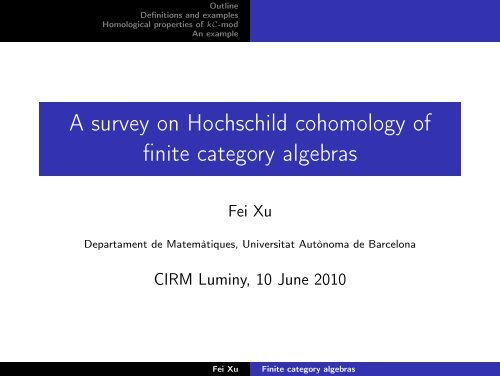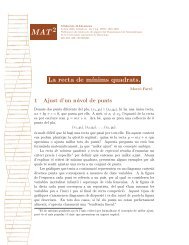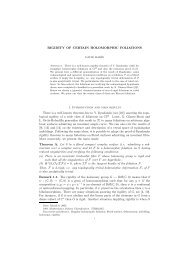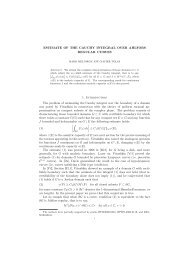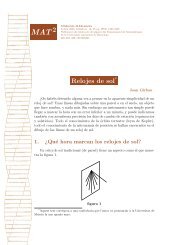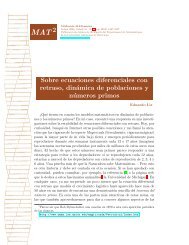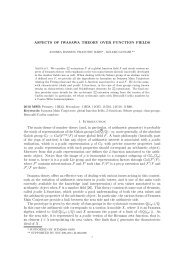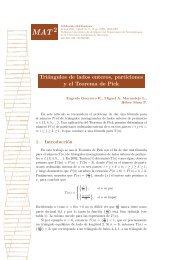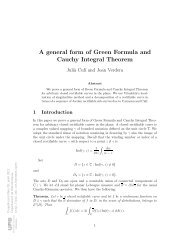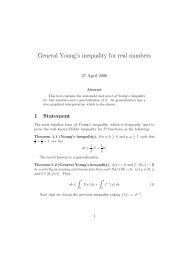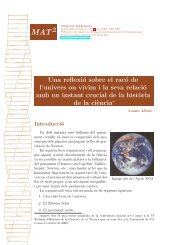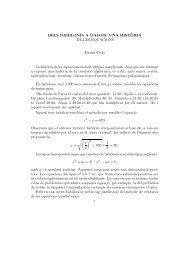my beamer presentation - Departament de matemà tiques
my beamer presentation - Departament de matemà tiques
my beamer presentation - Departament de matemà tiques
Create successful ePaper yourself
Turn your PDF publications into a flip-book with our unique Google optimized e-Paper software.
Outline<br />
Definitions and examples<br />
Homological properties of kC-mod<br />
An example<br />
A survey on Hochschild cohomology of<br />
finite category algebras<br />
Fei Xu<br />
<strong>Departament</strong> <strong>de</strong> Matemàtiques, Universitat Autònoma <strong>de</strong> Barcelona<br />
CIRM Luminy, 10 June 2010<br />
Fei Xu<br />
Finite category algebras
Outline<br />
Definitions and examples<br />
Homological properties of kC-mod<br />
An example<br />
1 Definitions and examples<br />
Finite categories and their algebras<br />
Re<strong>presentation</strong>s and modules<br />
Motivation<br />
2 Homological properties of kC-mod<br />
A closed symmetric monoidal category<br />
Adjoint functors and a spectral sequence<br />
Two categorical constructions<br />
Hochschild cohomology<br />
3 An example<br />
Fei Xu<br />
Finite category algebras
Outline<br />
Definitions and examples<br />
Homological properties of kC-mod<br />
An example<br />
Finite categories and their algebras<br />
Re<strong>presentation</strong>s and modules<br />
Motivation<br />
Finite categories<br />
A category is finite if it has finitely many morphism.<br />
Typical examples are finite groups and finite posets<br />
(partially or<strong>de</strong>red sets).<br />
A non-group and non-poset example<br />
1 x <br />
x<br />
α<br />
1 y<br />
<br />
y<br />
g<br />
with g 2 = 1 y and α = gα.<br />
Fei Xu<br />
Finite category algebras
Outline<br />
Definitions and examples<br />
Homological properties of kC-mod<br />
An example<br />
Category algebras<br />
Finite categories and their algebras<br />
Re<strong>presentation</strong>s and modules<br />
Motivation<br />
The k-category algebra of C, kC, is <strong>de</strong>fined as a k-vector<br />
space k Mor C, in which the multiplication is given on base<br />
elements by<br />
{ α ◦ β, if α and β are composable in C;<br />
α ∗ β =<br />
0 , otherwise.<br />
The previous category<br />
1 x <br />
x<br />
α<br />
1 y<br />
<br />
y<br />
has the following k-category algebra with i<strong>de</strong>ntity<br />
1 kC = 1 x + 1 y<br />
Fei Xu Finite category algebras<br />
g
Outline<br />
Definitions and examples<br />
Homological properties of kC-mod<br />
An example<br />
B. Mitchell’s theorem<br />
Finite categories and their algebras<br />
Re<strong>presentation</strong>s and modules<br />
Motivation<br />
Given a finite category algebra kC, we are interested in<br />
the homological properties of kC-mod of finitely<br />
generated left kC-modules.<br />
Let Vect k be the category of finite-dimensional k-vector<br />
spaces, and Vectk<br />
C the category of covariant functors.<br />
Each functor is called a k-re<strong>presentation</strong> of C.<br />
Mitchell’s Theorem: kC-mod ∼ = Vect C k .<br />
It simply says that each kC-module corresponds uniquely<br />
to a k-re<strong>presentation</strong> of C, and vice versa.<br />
F ↦→ ⊕ x∈Ob C F (x) and M ↦→ F M such that<br />
F M (x) = 1 x · M.<br />
Fei Xu<br />
Finite category algebras
Outline<br />
Definitions and examples<br />
Homological properties of kC-mod<br />
An example<br />
Finite categories and their algebras<br />
Re<strong>presentation</strong>s and modules<br />
Motivation<br />
Ordinary cohomology, an algebraic <strong>de</strong>finition<br />
For any M, N ∈ kC-mod, we can consi<strong>de</strong>r Ext ∗ kC(M, N).<br />
There is a constant functor k ∈ Vectk<br />
C such that<br />
k(x) = k and k(α) = Id k for any α ∈ Mor C. It is also<br />
called the trivial kC-module.<br />
There is an augmentation map ɛ : kC → k.<br />
The groups Ext ∗ kC(k, N) have different interpretations.<br />
∗<br />
They are isomorphic to both lim N, the higher limits<br />
←− C<br />
of N, and H ∗ (C; N), the cohomology of C with<br />
coefficients in N.<br />
Ext ∗ kC(k, k) possesses a cup product and is isomorphic to<br />
H ∗ (BC, k), the cohomology ring of the classifying<br />
space BC of C. It is called the ordinary cohomology ring<br />
of kC.<br />
Fei Xu<br />
Finite category algebras
Outline<br />
Definitions and examples<br />
Homological properties of kC-mod<br />
An example<br />
Transporter categories<br />
Finite categories and their algebras<br />
Re<strong>presentation</strong>s and modules<br />
Motivation<br />
Let G be a finite group and P a finite G-poset. One can<br />
construct the transporter category G ⋉ P as follows:<br />
The objects Ob(G ⋉ P) = Ob P;<br />
For x, y ∈ Ob(G ⋉ P), a morphism is a pair (g, gx ≤ y)<br />
for some g ∈ G.<br />
If G acts trivially, then the category is G × P.<br />
P ↩→ G ⋉ P via (x ≤ y) ↦→ (e, x ≤ y) (e ∈ G is the<br />
i<strong>de</strong>ntity).<br />
It admits a natural functor G ⋉ P → G, x ↦→ ∗ and<br />
(g, gx ≤ y) ↦→ g.<br />
It is a special situation of the Grothendieck<br />
construction on a functor F : C → CAT .<br />
Fei Xu<br />
Finite category algebras
A Σ 4 -poset<br />
Outline<br />
Definitions and examples<br />
Homological properties of kC-mod<br />
An example<br />
Finite categories and their algebras<br />
Re<strong>presentation</strong>s and modules<br />
Motivation<br />
The poset of all non-trivial 2-subgroups of Σ 4 , S 2 (Σ 4 ):<br />
· · ·<br />
· · ·<br />
D 8 <br />
D 8 D 8<br />
<br />
<br />
C 2 × C 2 C 4 V<br />
<br />
<br />
<br />
<br />
C 2<br />
C 2<br />
C 2<br />
<br />
C 2<br />
C 2<br />
Fei Xu<br />
Finite category algebras
Outline<br />
Definitions and examples<br />
Homological properties of kC-mod<br />
An example<br />
Finite categories and their algebras<br />
Re<strong>presentation</strong>s and modules<br />
Motivation<br />
The transporter category Σ 4 ⋉ S 2 (Σ 4 ) :<br />
C 2<br />
<br />
8<br />
8<br />
C 2 × C 2<br />
8<br />
4 <br />
C<br />
4 2<br />
8<br />
· · ·<br />
· · ·<br />
4 4 <br />
D 8 D<br />
4 8 D<br />
4 8<br />
<br />
<br />
8 8 24<br />
<br />
24 24<br />
<br />
C 4 8 V 24<br />
<br />
<br />
8 24<br />
8 24 24 <br />
8 8 <br />
C 2 C<br />
8 2 C<br />
8 2<br />
4<br />
4<br />
8<br />
8<br />
8<br />
Fei Xu<br />
Finite category algebras
Outline<br />
Definitions and examples<br />
Homological properties of kC-mod<br />
An example<br />
Finite categories and their algebras<br />
Re<strong>presentation</strong>s and modules<br />
Motivation<br />
Subgroups as transporter categories<br />
Let G be a finite group and H a subgroup. We consi<strong>de</strong>r<br />
the set of left cosets Q := G/H which can be regar<strong>de</strong>d as<br />
a G-poset: G acts via left multiplication.<br />
The transporter category G ⋉ Q is a connected groupoid<br />
whose skeleton is isomorphic to H.<br />
In this way one can recover all subgroups of G, up to<br />
category equivalences.<br />
A category equivalence D → C induces a Morita<br />
equivalence kD ≃ kC (and a homotopy equivalence<br />
BD ≃ BC as well).<br />
The functor G ⋉ Q → G gives rise to the usual<br />
restriction and transfer between H ∗ (G; k) and H ∗ (H; k).<br />
Fei Xu<br />
Finite category algebras
Outline<br />
Definitions and examples<br />
Homological properties of kC-mod<br />
An example<br />
Finite categories and their algebras<br />
Re<strong>presentation</strong>s and modules<br />
Motivation<br />
Relevance in group re<strong>presentation</strong>s<br />
The transporter categories bridge up re<strong>presentation</strong>s of groups<br />
and of their local categories, through the following diagram<br />
<br />
G<br />
G ⋉ P <br />
which induces functors among module categories<br />
kG-mod<br />
k(G ⋉ P)-mod<br />
C<br />
kC-mod<br />
It certainly provi<strong>de</strong>s a framework to investigate and compare<br />
various re<strong>presentation</strong>s, and cohomology as well.<br />
Fei Xu Finite category algebras
Outline<br />
Definitions and examples<br />
Homological properties of kC-mod<br />
An example<br />
Finite categories and their algebras<br />
Re<strong>presentation</strong>s and modules<br />
Motivation<br />
A proper setting for ordinary cohomology<br />
The natural functor π : G ⋉ P → G induces a ring<br />
homomorphism, the restriction,<br />
H ∗ (G; k) → H ∗ (G ⋉ P; k).<br />
Becker and Gottlieb constructed a transfer map<br />
H ∗ (G ⋉ P; k) → H ∗ (G; k) such that tr ◦ res = χ(P), the<br />
Euler characteristic of P.<br />
Applying a spectral sequence to P ↩→ G ⋉ P → G one<br />
can show H ∗ (G ⋉ P; k) is a finitely generated<br />
H ∗ (G; k)-module, and hence is finitely generated as a<br />
ring.<br />
Fei Xu<br />
Finite category algebras
Outline<br />
Definitions and examples<br />
Homological properties of kC-mod<br />
An example<br />
Finite categories and their algebras<br />
Re<strong>presentation</strong>s and modules<br />
Motivation<br />
Hochschild cohomology rings of transporter<br />
category algebras<br />
Let G be a finite group, P a finite G-poset and G ⋉ P<br />
the transporter category.<br />
The previously mentioned spectral sequence for<br />
P ↩→ G ⋉ P → G can be used to improve our<br />
observation on the finite generation of<br />
H ∗ (G ⋉ P; k) ∼ = Ext ∗ k(G⋉P)(k, k).<br />
Given a k(G ⋉ P)-module N, Ext ∗ k(G⋉P)(k, N) is finitely<br />
generated as a Ext ∗ k(G⋉P)(k, k)- and Ext ∗ kG(k, k)-module.<br />
With a bit extra work, one shows that the Hochschild<br />
cohomology ring HH ∗ (k(G ⋉ P)) is finitely generated<br />
as a Ext ∗ k(G⋉P)(k, k)-module, and hence is finitely<br />
generated as a ring.<br />
Fei Xu Finite category algebras
Outline<br />
Definitions and examples<br />
Homological properties of kC-mod<br />
An example<br />
A closed symmetric monoidal category<br />
Adjoint functors and a spectral sequence<br />
Two categorical constructions<br />
Hochschild cohomology<br />
A crash introduction to closed symmetric monoidal<br />
categories<br />
Mac Lane: Much of the force of category theory will be seen to<br />
resi<strong>de</strong> in using categories with specified additional structures.<br />
One basic example will be the closed categories. The simplest<br />
closed symmetric monoidal category is perhaps Vect k .<br />
There is a tensor product − ⊗ k −, which is symmetric.<br />
There exists a tensor i<strong>de</strong>ntity k.<br />
It is closed in the sense that for a pair of (or<strong>de</strong>red) spaces<br />
V , W , there is a function object, a.k.a. the internal hom,<br />
Hom k (V , W ) in the category Vect k .<br />
Hom k (U ⊗ k V , W ) ∼ = Hom k (U, Hom k (V , W )).<br />
Fei Xu<br />
Finite category algebras
Outline<br />
Definitions and examples<br />
Homological properties of kC-mod<br />
An example<br />
A closed symmetric monoidal category<br />
Adjoint functors and a spectral sequence<br />
Two categorical constructions<br />
Hochschild cohomology<br />
kC-mod is closed symmetric monoidal<br />
If A is a symmetric monoidal category, so is A C .<br />
The tensor product in kC-mod ≃ Vectk<br />
C is written as<br />
− ˆ⊗−. It is symmetric and has k as tensor i<strong>de</strong>ntity.<br />
The tensor product induces a cup product<br />
∪ : Ext i kC(M, N)⊗Ext j kC (M′ , N ′ ) → Ext i+j<br />
kC (M ˆ⊗M ′ , N ˆ⊗N ′ ).<br />
For any or<strong>de</strong>red pair of kC-modules M, N, Hom k (M, N) is<br />
not a kC-module. However there exists an internal hom<br />
such that Hom kC (L ˆ⊗M, N) ∼ = Hom kC (L, hom(M, N)).<br />
The algebra kC behaves in many ways like a<br />
cocommutative Hopf algebra, but is essentially different.<br />
Fei Xu<br />
Finite category algebras
Outline<br />
Definitions and examples<br />
Homological properties of kC-mod<br />
An example<br />
A closed symmetric monoidal category<br />
Adjoint functors and a spectral sequence<br />
Two categorical constructions<br />
Hochschild cohomology<br />
Standard tools<br />
Let θ : D → C be a functor between two finite categories. It<br />
induces a natural functor, the restriction along θ,<br />
Res θ : kC-mod → kD-mod.<br />
This functor comes with two adjoints, the left and right Kan<br />
extensions<br />
LK θ , RK θ : kD-mod → kC-mod.<br />
When C = G is a group, D = H is a subgroup and θ is the<br />
inclusion, we have Res θ<br />
∼ =↓<br />
G<br />
H and LK θ<br />
∼ =↑<br />
G<br />
H<br />
∼ =⇑<br />
G<br />
H<br />
∼ = RKθ .<br />
For any N ∈ kD-mod, there is a (multiplicative) cohomology<br />
Grothendieck spectral sequence<br />
H i (C; H j (\θ; N)) ⇒ H i+j (D; N).<br />
Fei Xu<br />
Finite category algebras
Outline<br />
Definitions and examples<br />
Homological properties of kC-mod<br />
An example<br />
A closed symmetric monoidal category<br />
Adjoint functors and a spectral sequence<br />
Two categorical constructions<br />
Hochschild cohomology<br />
Diagonal subcategory and functor<br />
We can consi<strong>de</strong>r the algebra of the product category<br />
C × C, k(C × C).<br />
It is easy to see that k(C × C) ∼ = kC ⊗ k kC. In particular<br />
there are algebra homomorphisms k1 kC ⊗ kC ↩→ kC ⊗ kC<br />
and kC ⊗ k1 kC ↩→ kC ⊗ kC.<br />
The category C × C has a diagonal subcategory ∆C,<br />
whose objects are of the form (x, x) for any x ∈ Ob C and<br />
whose morphisms are of the form (α, α) for any<br />
α ∈ Mor C. There is an isomorphism ∆C ∼ = C.<br />
We shall consi<strong>de</strong>r ∆ : C → C × C and RK ∆ .<br />
Fei Xu<br />
Finite category algebras
Outline<br />
Definitions and examples<br />
Homological properties of kC-mod<br />
An example<br />
A closed symmetric monoidal category<br />
Adjoint functors and a spectral sequence<br />
Two categorical constructions<br />
Hochschild cohomology<br />
Right Kan extension and internal hom<br />
Let M, N ∈ kC-mod. Then M ⊗ N is a kC ⊗ kC-module.<br />
M ˆ⊗N = Res ∆ (M ⊗ N) where Res ∆ : kC ⊗ kC-mod<br />
→ kC-mod.<br />
Thus<br />
Hom kC (L ˆ⊗M, N) = Hom kC (Res ∆ (L ⊗ M), N)<br />
∼ = HomkC⊗kC (L ⊗ M, RK ∆ N)<br />
∼ = HomkC (L, Hom kC (M, RK ∆ N)).<br />
The internal hom is hom(M, N) = Hom kC (M, RK ∆ N).<br />
The dual module of M is <strong>de</strong>fined to be hom(M, k).<br />
When C = G is a group, hom(M, N) ∼ = Hom k (M, N).<br />
Fei Xu<br />
Finite category algebras
Outline<br />
Definitions and examples<br />
Homological properties of kC-mod<br />
An example<br />
A closed symmetric monoidal category<br />
Adjoint functors and a spectral sequence<br />
Two categorical constructions<br />
Hochschild cohomology<br />
Category of factorizations and skew diagonal<br />
functor<br />
We also need the opposite category C op because<br />
kC op ∼ = (kC) op , and the category algebra<br />
kC e := k(C × C op ) is isomorphic to the enveloping algebra<br />
(kC) e = kC ⊗ k kC op .<br />
Note that kC as a functor C × C op → Vect k is given by<br />
kC(x, y) = k Hom C (y, x) (zero if Hom C (y, x) = ∅).<br />
There is a category of factorizations in C, named<br />
F (C). Its objects are the morphisms in C and there is a<br />
morphism from α → β if and only if α is a factor of β. If<br />
β = uαv, then the morphism is recor<strong>de</strong>d as a pair<br />
(u, v) : α → β.<br />
The category is topologically the same as C in that<br />
Fei Xu Finite category algebras
Outline<br />
Definitions and examples<br />
Homological properties of kC-mod<br />
An example<br />
Using the left Kan extension<br />
A closed symmetric monoidal category<br />
Adjoint functors and a spectral sequence<br />
Two categorical constructions<br />
Hochschild cohomology<br />
We examine the following diagram<br />
F (C)<br />
<br />
τ=(t,s)<br />
C × C op<br />
t<br />
pr<br />
<br />
C .<br />
It immediately gives rise to another diagram<br />
Res τ<br />
kF (C)-mod<br />
k(C × C op )-mod<br />
Res t<br />
Res<br />
<br />
pr<br />
kC-mod<br />
.<br />
Fei Xu<br />
Finite category algebras
Outline<br />
Definitions and examples<br />
Homological properties of kC-mod<br />
An example<br />
A closed symmetric monoidal category<br />
Adjoint functors and a spectral sequence<br />
Two categorical constructions<br />
Hochschild cohomology<br />
Using the left Kan extension, continued<br />
It leads to a diagram that we need<br />
LK τ<br />
kF (C)-mod<br />
k(C × C op )-mod<br />
LK t<br />
LK<br />
<br />
pr<br />
kC-mod .<br />
k<br />
LK τ<br />
kF (C)-mod<br />
<br />
kC e -mod kC<br />
LK t<br />
LK pr ∼ =−⊗kC k<br />
<br />
kC-mod .<br />
Fei Xu<br />
k<br />
Finite category algebras
Outline<br />
Definitions and examples<br />
Homological properties of kC-mod<br />
An example<br />
A closed symmetric monoidal category<br />
Adjoint functors and a spectral sequence<br />
Two categorical constructions<br />
Hochschild cohomology<br />
Example: Hochschild cohomology of a poset<br />
Let P be a poset. We have HH ∗ (kP) ∼ = H ∗ (P; k)<br />
(Gerstenhaber-Shack). When P = x α →y, the triple<br />
τ : F (P) → P e becomes<br />
(α,1 x )<br />
<br />
[1 x ]<br />
[α] (y, x)<br />
<br />
<br />
(1 y ,α)<br />
<br />
[1 y ]<br />
(α,1 op<br />
x )<br />
<br />
(x, x)<br />
<br />
(1 x ,α op )<br />
(1 y ,α op )<br />
(α,1 op<br />
y )<br />
<br />
(x, y)<br />
Note that<br />
kP(x, x) = k1 x , kP(y, y) = k1 y , kP(y, x) = kα and<br />
kP(x, y) = 0. Moreover Res τ kP = kP ∼ = k.<br />
Fei Xu Finite category algebras<br />
(y, y)
Outline<br />
Definitions and examples<br />
Homological properties of kC-mod<br />
An example<br />
A closed symmetric monoidal category<br />
Adjoint functors and a spectral sequence<br />
Two categorical constructions<br />
Hochschild cohomology<br />
Thus we have<br />
HH ∗ (kP) ∼ = Ext ∗ kPe(kP, kP)<br />
∼ = Ext ∗ kF (P)(k, k)<br />
∼ = Ext ∗ kP(k, k)<br />
∼ =<br />
H ∗ (P; k).<br />
Fei Xu<br />
Finite category algebras
Outline<br />
Definitions and examples<br />
Homological properties of kC-mod<br />
An example<br />
A closed symmetric monoidal category<br />
Adjoint functors and a spectral sequence<br />
Two categorical constructions<br />
Hochschild cohomology<br />
Theorem<br />
For any M ∈ kC e -mod,<br />
Ext ∗ kC e(kC, M) ∼ = Ext ∗ kF (C)(k, Res τ M);<br />
For any N ∈ kC-mod, Ext ∗ kC(k, N) ∼ = Ext ∗ kF (C)(k, Res t N);<br />
The module kC ∈ kC e -mod restricts to<br />
Res τ kC ∼ = k ⊕ U ∈ kF (C)-mod;<br />
There exists a natural split surjective ring homomorphism<br />
Ext ∗ kC e(kC, kC) → Ext∗ kC(k, k) ∼ = Ext ∗ kF (C)(k, k).<br />
We can un<strong>de</strong>rstand Hochschild cohomology via ordinary<br />
cohomology.<br />
Fei Xu<br />
Finite category algebras
Outline<br />
Definitions and examples<br />
Homological properties of kC-mod<br />
An example<br />
<br />
<br />
<br />
<br />
Example: a 7-dimensional algebra<br />
A category constructed by Aurélien Djament: E<br />
h<br />
g<br />
x<br />
1 x<br />
gh<br />
α<br />
β<br />
y {1 y } ,<br />
where g 2 = h 2 = 1 x , gh = hg, αh = βg = α, and<br />
αg = βh = β. Its category algebra is 7-dimensional and we<br />
can compute the mod-2 ordinary and Hochschild cohomology<br />
rings.<br />
BE is homotopy equivalent to B(C 2 × C 2 )/BC 2 .<br />
Suppose chark = 2. Then H ∗ (BE, k) is isomorphic to a<br />
subring of the polynomial ring k[u, v] with base elements<br />
of the form u i , i ≥ 1, removed.<br />
Fei Xu<br />
Finite category algebras
Outline<br />
Definitions and examples<br />
Homological properties of kC-mod<br />
An example<br />
Infinitely generated HH ∗<br />
The ordinary cohomology ring is infinitely<br />
generated and has no nilpotents. Thus HH ∗ (kE) is<br />
not finitely generated either, even modulo nilpotents.<br />
This calculation is very similar to that of the Hochschild<br />
cohomology ring of a Koszul algebra. In fact, kE is<br />
Koszul.<br />
Let A be a Koszul algebra and r its radical. Then the<br />
image of the following canonical map<br />
Ext ∗ −⊗<br />
Ae(A, A)<br />
A A/r<br />
Ext ∗ A(A/r, A/r)<br />
is exactly the (gra<strong>de</strong>d) center.<br />
Snashall constructed Koszul algebras with infinitely<br />
generated Hochschild cohomology rings (modulo<br />
nilpotents) in<strong>de</strong>pen<strong>de</strong>nt Fei Xuof the Finitechoice category algebras of a base field.
Compatibility<br />
Outline<br />
Definitions and examples<br />
Homological properties of kC-mod<br />
An example<br />
There exists a commutative diagram<br />
Ext ∗ kE e(kE, kE)<br />
−⊗ kE k<br />
−⊗ kE kE/r<br />
<br />
Ext ∗ kE(k, k)<br />
Ext ∗ kE(kE/r, kE/r).<br />
− ˆ⊗kE/r<br />
Fei Xu<br />
Finite category algebras
Outline<br />
Definitions and examples<br />
Homological properties of kC-mod<br />
An example<br />
J. C. Becker, D. H. Gottlieb, The transfer map and fibre<br />
bundles, Topology 14 (1975) 1-12.<br />
W. G. Dwyer, H.-W. Henn, Homotopy Theoretic Methods<br />
in Group Cohomology, Birkhäuser 2001. (Grothendieck<br />
constr.)<br />
P. Hilton, U. Stammbach, A Course in Homological<br />
Algebra (Second edition), GTM 4, Springer 1997. (Kan<br />
extensions, Grothendieck s.s.)<br />
S. Mac Lane, Categories for the Working Mathematician<br />
(Second edition), GTM 5, Springer 1998. (various<br />
categorical constructions)<br />
I. Moerdijk, J. A. Svensson, A Shapiro lemma for diagram<br />
of spaces with applications to equivariant topology,<br />
Compositio Math. 96 (1995) 249-282. (Grothendieck<br />
s.s.)<br />
D. Quillen, Higher algebraic K-theory I, in: Lecture Notes<br />
Fei Xu Finite category algebras
Outline<br />
Definitions and examples<br />
Homological properties of kC-mod<br />
An example<br />
J. Thévenaz, G-algebras and Modular Re<strong>presentation</strong><br />
Theory, Oxford University Press 1995. (transporter<br />
categories, local categories)<br />
R. W. Thomason, Homotopy colimits in the category of<br />
small categories, Math. Proc. Camb. Phil. Soc. 85<br />
(1979) 91-109. (Grothendieck construction)<br />
P. J. Webb, An introduction to the re<strong>presentation</strong>s and<br />
cohomology of categories, in: Group Re<strong>presentation</strong><br />
Theory, EPFL Press 2007, pp. 149-173.<br />
F. Xu, Hochschild and ordinary cohomology rings of small<br />
categories, Adv. Math. 219 (2008) 1872-1893.<br />
F. Xu, Tensor structure on kC-mod and cohomology,<br />
preprint 2009.<br />
Fei Xu<br />
Finite category algebras


